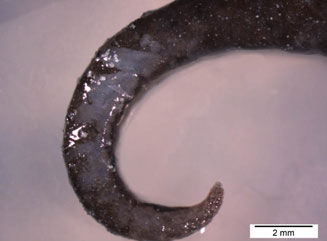Diseased seahorses: white necrotic tail tips in estuary seahorses
 Seahorses are classified as threatened species. They are popular in global aquarium trade but in captivity, they are very susceptible to parasitic, fungal and bacterial ailments. White discolouration of the tail is a frequently occurring phenomenon, well-known amongst seahorse keepers, but still with an unclear origin.
Seahorses are classified as threatened species. They are popular in global aquarium trade but in captivity, they are very susceptible to parasitic, fungal and bacterial ailments. White discolouration of the tail is a frequently occurring phenomenon, well-known amongst seahorse keepers, but still with an unclear origin.
Seven seahorses displaying white necrotic tails transforming into white patches covering the distal part of the tail, were brought to the Faculty of Veterinary Medicine at Ghent University. Early observations in the disease stadium were agitated swimming behaviour, scraping with the tail and an increased breathing ratio. Gradually, the soft tissue of the distal part of the tail disappeared and in some cases led to the exposure of the vertebral column, resulting in the death of the animal.
Protozoans were observed on the skin samples with a morphology resembling that of species belonging to the genus Uronema (Scuticociliatida). Scuticociliates may become opportunistic histophagous parasites causing severe infections in marine fish, crustaceans and molluscs. The presence of these ciliates in fish tissues has been associated with pathological signs, including skin ulcers spreading into muscular tissue and even exposing the fin rays. Massive clusters of bacterial cells, exhibiting the same morphology as Tenacibaculum aestuarii, were observed invading the subcutaneous tissue. This Tenacibaculum species has never before been associated with neither disease signs nor mortality, however, various members belonging to the family Flavobacteriaceae are notorious pathogens in the aquaculture industry and the ornamental fish sector.
Additional studies are required to rectify or dismantle the above hypothesis that both scuticociliatosis and Tenacibaculum rank amongst the causative agents of white tail disease.
Published paper (Short communication), read it here. Authors: A.M. Declercq, K. Chiers, W. Van den Broeck, A. Rekecki, S. Teerlinck, D. Adriaens, F. Haesebrouck and A. Decostere.
